Specialized Saddles are compared below to 4 different types of saddles. A Pad that measures pounds per square inch (PSI) was used in each of the comparisons. These comparisons were done all with the same horse, same rider, and on the same day. Note, when PSI is 5 and above blood flow can become restricted. This can cause soreness in the back and over time white spots will appear from nerve damage caused by these high pressure points.
Compare Specialized Saddles to:
Click the links above to view a specific section.
Comparing Specialized Saddles to Treeless Saddles
Treeless saddles are saddles with no tree, basically a saddle with no bones, and without the tree they cannot distribute pressure evenly. When a rider is sitting the pressure is applied directly under the seat in a relatively small circular area causing pressure over 5 psi and restricts blood flow to this area (shown in yellow and red below). The red spot below at the “rear” is directly under the seat. The red spot in the front is from the stirrups hanging over the spine.
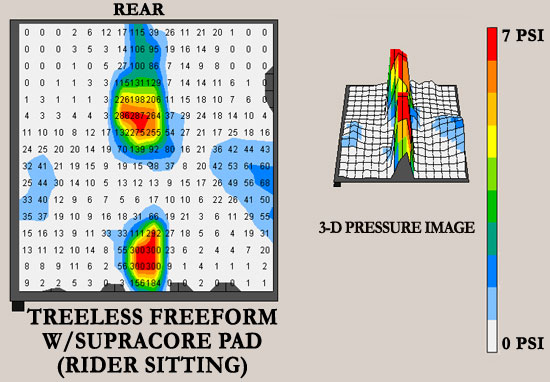
When a rider rises to post in stirrups the pressure is applied along the spine in the center of back. This is a place you never want to put pressure because the vertical spinal processes of the spinal column have no muscling over them, only skin and nerves, and pressure here is very painful for the horse. The image below shows when a rider is posting and the pressure is put directly on the spine from the stirrups when the rider gets up to post.
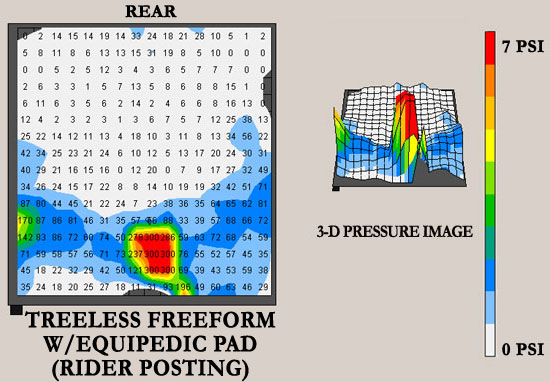
Pads with foam inserts can help minimize this spinal pressure but it still exists. Compare the image of Supracore pad and pad with foam inserts under a treeless saddle shown here to see what your horse’s back experiences. Treeless saddles they can be an improvement over a very bad fitting tree, but are not nearly as effective toward the goal of even pressure distribution and low psi as a precision fit system like that found in the Specialized Saddles.
Shown below is the same rider on the same horse in a Specialized Saddle. All pressure is under 3 psi (excellent range) and it had no weight on the spine down the spinal channel.
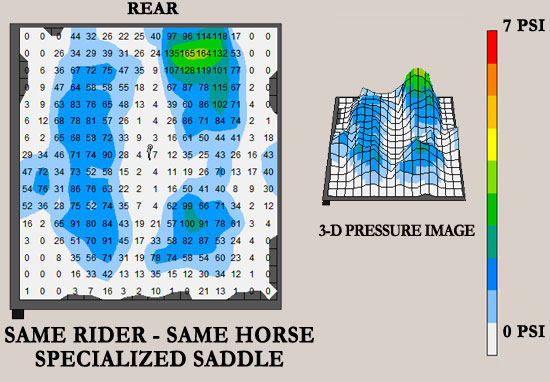
Compare Specialized Saddles to Flex Panel Saddles
Flex Panel type saddles, including Ortho Flex, American Flex and ROC have flexible plastic panels attached at four points. If you push in the middle of the panel you notice they flex, offering no support in the middle, where the horse’s back is best suited to carry weight. The only place they support is at the four points of attachment to the tree. These attachment bolts are often positioned over the loins and shoulders. The pressure pad image shows four circles of pressure when testing these type saddles, with no support in the center. Please examine the pressure pad images shown below for graphical proof (as you scroll down you will see the images).*
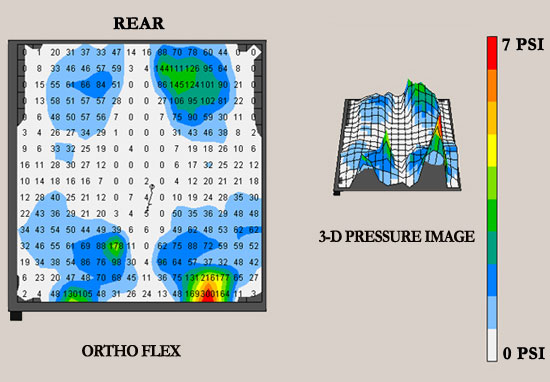
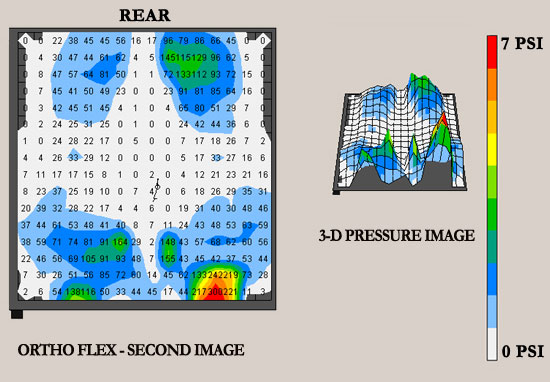
Here (below) is an image of same weight rider in a Specialized Saddle. Note the even, light pressure spread evenly along the bars with slightly higher pressure under rider’s seat.
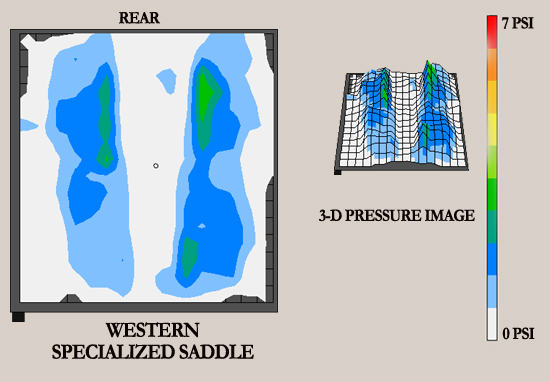
Compare Specialized Saddles to Traditional Western Saddles
The traditional western saddle often is too tight due to substantial padding. The tradition of using both a blanket and pad, combined with the popularity of today’s thicker pads, often creates bridging. Complicating the issue is the use of bulky, thick leather, double-thick skirting encasing the tree, and extending two to three inches in front of the bars of the tree. This often pinches the shoulders and interferes with the tree fitting in the manner it was designed to.
Specialized Saddles have eliminated this unnecessary leather in front of bars and shortened bars slightly so shoulder movement isn’t as compromised as on most other western saddles For more on the effect of padding and how it affects saddle fit see “The Pad Paradox” article by clicking here. Evaluating saddle fit on a fleece-lined western saddle is difficult.
Specialized Saddles builds in the padding and nothing to distort fit is added after you adjust it to fit your horse. The smooth surface of the neoprene pads on a Specialized Saddle lets you see exactly how your saddle fits and the adjustable system lets you dial it in exactly for a perfect fit without using any tools!*
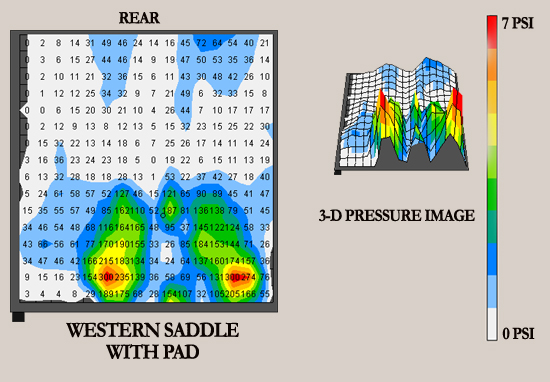
As a result of saddle either being too narrow or too much padding, all pressure is on withers/shoulders. This failure of saddle to fit properly results in it being lifted off back, in center, and some remaining pressure is on loins where contact resumes. This condition is referred to as “bridging”, like a bridge spanning a gully, resting only on the front and back. Horses experiencing this will be reluctant to extend their gaits and this much pressure will cause pain, tissue damage and associated white hairs.
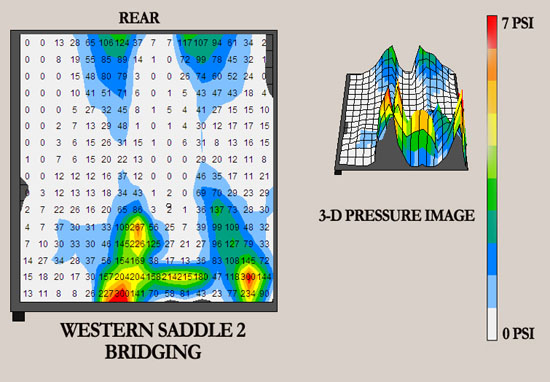
Here (below) is an image of same weight rider in a Specialized Saddle. Note even, light pressure spread evenly along the bars with slightly higher pressure under rider’s seat.

Compare Specialized Saddles to Traditional English Saddles
English saddles are made using flocked panels. The shape of the surface of these panels are curved or convex. That way, no matter what the angle of the horse, there is some contact in the middle of that curved panel. The use of a curved surface results in a fairly narrow strip of contact resulting in a rather small area to distribute the weight of saddle and rider.*
Specialized English Saddles are the only saddles built with flat bars rather than flocked panels, enabling the weight of saddle and rider to be distributed over a much larger surface. Please examine the pressure pad images shown below for graphical proof (as you scroll down you will see the images).

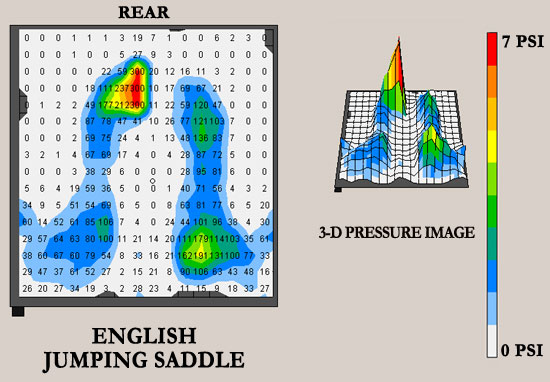
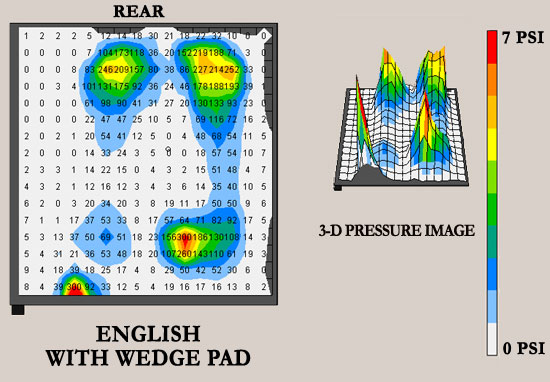
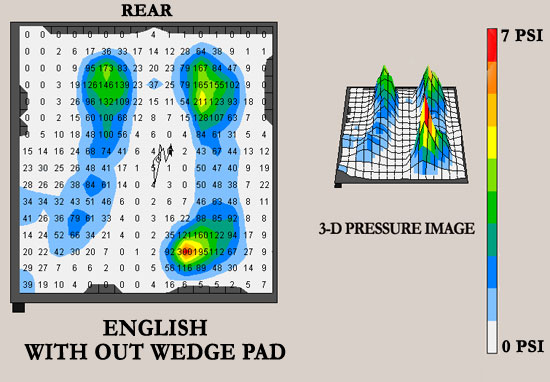
* All images shown here were taken from a fitting session in Burbank California in which people brought their saddles to check fit on their horses. We have made no effort to negatively portray the fit image of any saddle.